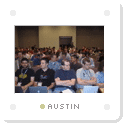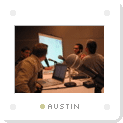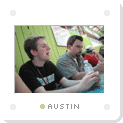Capturing SXSW
When I finally met Hugh Forrest for the first time in Austin this past week, I told him I keep thinking each year that SXSW is the biggest it can possibly get. That there’s no way the following year can top the previous year in terms of the talent he pulls in for speakers, and the amount of interesting people attending who are so open and receptive to new ideas. Each time I’ve been wrong.
When I finally met Hugh Forrest for the first time in Austin this past week, I told him I keep thinking each year that SXSW is the biggest it can possibly get. That there’s no way the following year can top the previous year in terms of the talent he pulls in for speakers, and the amount of interesting people attending who are so open and receptive to new ideas. Each time I’ve been wrong.

Last year’s thinking and this year’s festival was no exception. As the plans started to come together for this year’s event, it was obvious there were going to be lots of people converging in Austin from all over the globe. Friends from previous years returning again. And people I’ve gotten to know virtually over the past year whom I was looking forward to finally meeting in person.

In last year’s panel on “CSS, the good, the bad, and the ugly,” I went over my alloted time, and had to stop my presentation before getting to the concept of Double Rollovers used for the Adaptive Path partner photos. I’ve used that same technique in several other places since then. Because it can be used for changing more than just two objects on mouseover at a time, I renamed the technique Remote Rollovers. For the first few minutes, I walked through how it works, and reviewed a few examples of its use. A companion article is already in the works which reviews the same examples and provides more detail on implementing the technique.


As the photos show, from my perspective, SXSW is definitely about people. The people who speak and present their ideas, the people who attend, the people who ask provocative questions and challenge the panelists, the people with whom you get to spend an hour or two eating around a large table, discussing everything relevant to our worlds. It was a pleasure to spend time with so many friends this year, and to make acquaintances with quite a few new faces as well. I’m already looking forward to next year. Except that this time, I don’t think I’ll underestimate how big SXSW 2006 might be.
